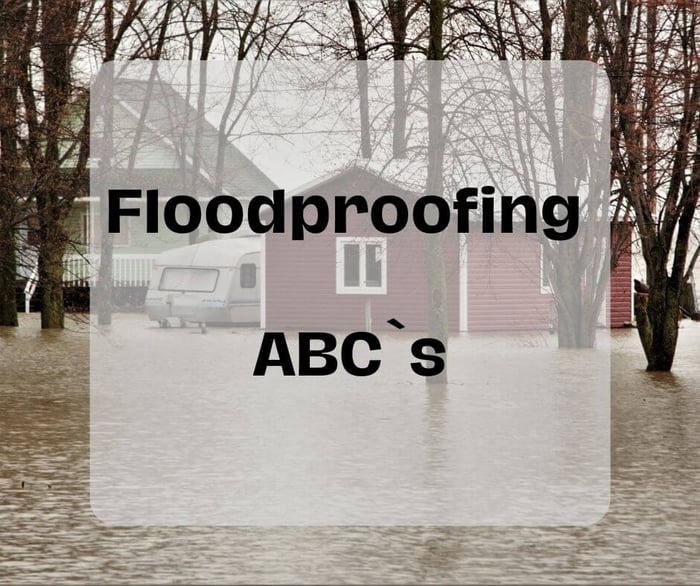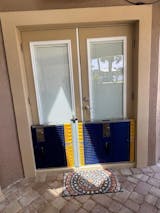Floodproofing is like giving your home a solid defense against floods. It's about doing things to make sure your place stays safe and dry when there's too much water.
You can build walls or barriers to keep the water out, use special seals on doors and windows to stop leaks, or even lift your house a bit to keep it above the floodwater.
So, floodproofing is just being smart and taking steps to keep your home safe from floods. It's like giving your house protection against water problems!
But how do you make sure that your house or business is floodproof? And how do you know if you need to protect from floods at all?
Here are some things you need to know about flood safety:
How do I know if my house needs floodproofing?
Great question! Here are some signs that your house might need attention:
- Previous Flooding: If your area has a history of flooding, especially if your house has been flooded before, it's a clear sign that floodproofing could be beneficial.
- Proximity to Water Sources: If your home is close to rivers, lakes, or other bodies of water that can flood, you might want to consider floodproofing as a precaution.
- Frequent Heavy Rainfall: If your region experiences heavy rainfall or storms regularly, it increases the risk of flooding. Check if water tends to pool around your home during these times.
- Changes in Local Development: If there's new construction or changes in the landscape around your home, it could affect water drainage patterns, making floodproofing a wise choice.
- Elevation of Your Property: If your house is in a low-lying area, it's more susceptible to flooding. Consider flood control to elevate or protect your home from rising water.
- Weather Predictions: Pay attention to weather forecasts, especially during rainy seasons or when severe weather is expected. If flooding is a possibility, it's a good time to think about floodproofing measures.
- Insurance Recommendations: Some insurance companies may suggest or require floodproofing measures to reduce the risk of damage. Check with your insurance provider for guidance.
- Local Regulations: Be aware of local building codes and regulations related to flooding. If there are recommendations for your area, it's wise to follow them.
If anything from this list sounds familiar, it might be a good idea to consult with a local expert, such as a building inspector or floodplain manager. They can provide specific advice based on your home's location and potential risks. Remember, it's always better to be prepared!

How do I know if my house is flood-proof?
Suppose you have just bought your house. Of course, the seller was probably swearing for his life that you were getting the house for a price much lower than its actual value since it was so well maintained throughout its whole history. And, of course, it is floodproof and perfectly ready to protect you and your loved ones in case of flooding. Or, is it?
Here is how you know whether your house is safe:
- Review property documents: Check your property documents, including flood zone maps and elevation certificates. These documents may provide information on your property's flood risk and existing protective measures.
- Inspect Previous Flood History: If your house has experienced flooding before, it's a clear sign that additional floodproofing measures may be needed.
- Examine Building Elevation: Check if your house is elevated above the base flood elevation (BFE) determined by local authorities. If it is, it's a positive sign, but if it's below or near the BFE, further floodproofing may be necessary.
- Evaluate Foundation and Walls: Inspect the foundation and exterior walls for signs of vulnerability. Seepage, cracks, or other weaknesses can indicate areas where water might enter during a flood.
- Check Basement or Crawlspace: If your house has a basement or crawlspace, assess its susceptibility to flooding. Waterproofing measures, sump pumps, and proper drainage can be indicators of floodproofing efforts.
- Examine Doors and Windows: Look for features like watertight doors, flood shields, or window well covers. These additions can help prevent water from entering your home.
- Assess Landscaping: Evaluate the landscaping around your property. Proper grading and the presence of features like swales or berms can redirect water away from your home.
- Verify Insurance Coverage: Check your homeowner's insurance policy. If it includes coverage for flood damage, it's an indication that your insurer recognizes the flood risk, but that doesn't necessarily mean your house is fully floodproof.
- Consult with professionals: Seek advice from professionals, such as building inspectors or floodplain managers. They can provide expert opinions on your property's flood risk and suggest appropriate floodproofing measures.
- Consider Local Building Codes: Be aware of local building codes and regulations related to flooding. Compliance with these codes often involves specific floodproofing requirements.
The 10 essential steps to floodproofing your house.
So, how do you floodproof your house? There are millions of ways to make sure that floodwater will stay away from your doors. Some of them are pretty fundamental and will require serious dedication and investment. Others are relatively easy and even cheap, but no less efficient. Here are the 10 essential floodproofing tips that will instantly make your house much safer in case major flooding strikes tomorrow.
- Flood Barriers: Modern flood barriers are effective and relatively easy to install. They act as a protective barrier against rising water levels, creating a shield around your home. Some options include inflatable barriers, modular barriers, or sandbag alternatives.
- Seal Doors and Windows: Use weather-stripping or silicone sealant to seal gaps around doors and windows. This helps prevent water from seeping into your home during a flood.
- Elevate Electrical Systems: If possible, elevate electrical outlets, switches, and wiring to a level above potential floodwaters. This helps minimize the risk of electrical damage during a flood.
- Install Sump Pumps: Sump pumps are handy devices that can remove excess water from basements or crawlspaces. Installing one can help prevent water accumulation during floods.
- Raise Appliances and Utilities: Elevate heating systems, water heaters, and other utilities above the expected flood level. This reduces the risk of damage to these essential systems during a flood.
- Landscaping Adjustments: Modify the landscape around your house by grading the soil away from the foundation. This helps direct water away from the structure.
- Flood-Resistant Materials: Consider using water-resistant materials for flooring, walls, and other structural components. Materials like tile, pressure-treated wood, or waterproof wall coverings can be more resilient in the face of flooding.
- Window Well Covers: If you have basement windows, consider installing window well covers. These covers help keep water and debris out, reducing the risk of basement flooding.
- Backup Power Supply: Install a backup power supply for essential systems like sump pumps and flood alert systems. This ensures that flood protection measures continue to work even during power outages.
- Emergency Plan: Develop a flood emergency plan for your family. This includes knowing evacuation routes, having an emergency kit, and keeping important documents in a waterproof container.
It's important to note that, while these measures can help minimize flood risk, complete floodproofing may not be possible in every situation. Consulting with floodplain managers or professionals in flood mitigation can provide personalized advice based on your specific circumstances.
Contact Dam Easy today, and together we will make sure that your house is perfectly floodproof and safe. Florida residents can invite one of our teams directly to their house and get a full estimate of flood risks and qualified advice about floodproofing and modern flood control. However, we work worldwide. Our experts are available for online consultation. The Flood Barrier Calculator will help you estimate how many flood barriers you may need for thorough floodproofing, and worldwide delivery will allow you to get your flood barriers within a few business days.
Contact Dam Easy today and make floodproofing... Dam Easy!



















